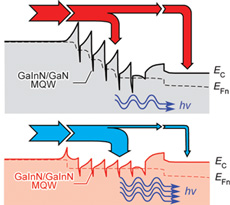

| Home | About Us | Contribute | Bookstore | Advertising | Subscribe for Free NOW! |
| News Archive | Features | Events | Recruitment | Directory |
| FREE subscription |
| Subscribe for free to receive each issue of Semiconductor Today magazine and weekly news brief. |
News
16 January 2009
RPI cuts LED efficiency droop via polarization-matched GaInN/GaInN MQWs
In collaboration with South Korea’s Samsung Electro-Mechanics Company, researchers at Rensselaer Polytechnic Institute (RPI) of Troy, NY, USA have demonstrated a blue multi-quantum-well (MQW) LED that reduces the droop in efficiency seen in conventional InGaN-based MQW LEDs at injection current densities above 10A/cm² (Jiuru Xu et al, Appl. Phys. Lett. 94 (2009), 011113).
“Today’s high-brightness LEDs are operated at current densities far beyond where efficiency peaks,” says project leader E. Fred Schubert, the Wellfleet Senior Constellation professor of Future Chips at RPI, and head of the its National Science Foundation-funded Smart Lighting Engineering Research Center. “This challenge has been a stumbling block, because reducing the current densities to values where LEDs are more efficient is unacceptable,” he adds.
The efficiency droop is due to a non-radiative carrier loss mechanism that is not yet fully understood. However, studies have shown that a likely cause is leakage of electrons at high current densities across the electron-blocking layer (EBL) followed by them recombining with holes outside the MQW active light-emitting region. This indicates that the conventional design of the conduction band is inadequate to prevent electrons from entering the p-side of the LED’s pn junction.
 Schubert’s team has found that the likely cause of this is that the active region contains materials with mismatched polarization at their heterointerfaces: conventional blue MQW LEDs in high-volume production have a GaInN/GaN active region consisting of gallium indium nitride quantum well layers separated by gallium nitride barrier layers.
Schubert’s team has found that the likely cause of this is that the active region contains materials with mismatched polarization at their heterointerfaces: conventional blue MQW LEDs in high-volume production have a GaInN/GaN active region consisting of gallium indium nitride quantum well layers separated by gallium nitride barrier layers.
Graphic: Simulated conduction-band diagram of conventional GaInN/GaN active region (top, black) and new polarization-matched GaInN/GaInN active region (bottom, red) at 100A/cm² forward current density.
The polarization mismatch leads to the formation of large sheet charges. This modifies the energy bands to form large triangular barriers in the active region and the EBL (see figure). The barriers create obstacles for charge carriers and hence require high forward voltages for significant currents to flow. The conduction band on the n-side of the pn junction is therefore significantly higher than the conduction band on the p-side, making it energetically favorable for electrons to escape to the p-side. Novel conduction-band engineering to reduce the polarization mismatch can hence result in better electron confinement and lower current leakage from the active region.
The researchers discovered that the polarization mismatch between the two GaInN/GaN well and barrier materials in the active region can be strongly reduced by introducing a new design of quantum barrier. Already, last July, RPI reported MOCVD-grown blue MQW LEDs emitting at a wavelength of 440nm with GaInN quantum wells but AlGaInN barriers that have the same energy bandgap as GaN but match the polarization of the GaInN quantum well (Schubert et al, Appl. Phys. Lett. 93 (2008), 041102). However, growing this structure with good crystal quality is difficult because the barrier layer demands great control of the aluminum and indium content.
Now, the AlGaInN has been replaced by the use of GaInN in barriers of what are now GaInN/GaInN active layers (maintaining the Al-free characteristic of the conventional GaInN/GaN MQW active region). This allows better matching of the polarization fields and hence much lower triangular barriers. Also, the conduction bands on both the n- and p-sides are about the same height, reducing the driving force for electron leakage out of the active region and hence reducing efficiency droop (with test results confirming theoretical simulations).
In tests, the external quantum efficiency (EQE) of a reference 440nm-wavelength blue LED with a conventional GaInN/GaN MQW active region peaked at just 4A/cm², and fell 50% by 300A/cm². By comparison, the EQE of the new polarization-matched GaInN/GaInN MQW LED peaked at 22A/cm², and outperformed the reference GaInN/GaN MQW LED above 34A/cm². Also, its peak EQE was 84% of the conventional GaInN/GaN MQW LED's peak EQE, which (due to the Al-free active region) is an improvement on less than 70% for RPI’s previous GaInN/AlGaInN MQW LED.
Also, compared to the reference GaInN/GaN MQW LED, at the maximum forward current density of 300A/cm² the polarization-matched GaInN/GaInN MQW LED exhibits an 18% increase in light output power. It also has a lower forward voltage, increasing the wall-plug efficiency by 22%. In addition, the ideality factor in the intermediate current range is reduced from 2.0 to just 1.7. The electroluminescence wavelength shift as the forward current changes from 10mA to 500mA is also reduced, from 4.9nm to 3.3nm.
“Matching polarization materials makes a big difference; it's not perfect yet, but we know we are definitely increasing the output power of LEDs at high current levels, which is exactly where it matters because for solid-state lighting we want to use LEDs for high-power illumination,” says Schubert.
See related item:
Fathoming efficiency droop in InGaN MQW-LEDs
See article: Solutions don’t solve droop controversy
![]() Search: Samsung Electro-Mechanics Rensselaer Blue MQW LEDs Droop MOCVD
Search: Samsung Electro-Mechanics Rensselaer Blue MQW LEDs Droop MOCVD
Visit: http://smartlighting.rpi.edu
